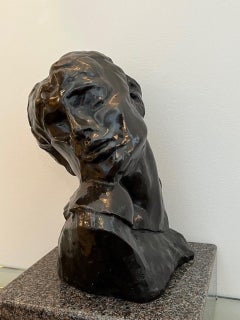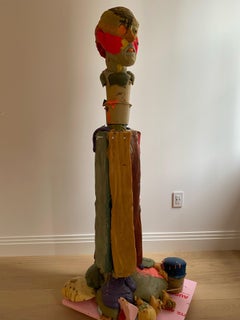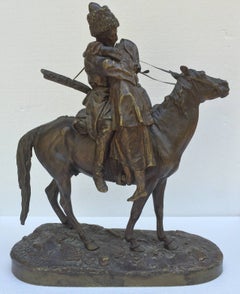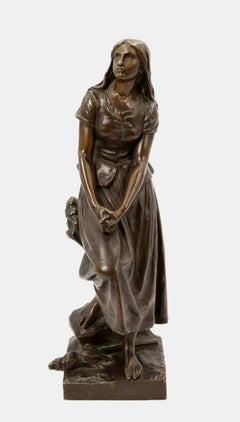Donna Leatherman Editions Figurative Sculptures
to
1
1
1
Overall Width
to
Overall Height
to
1
1
1
1
1
1
2
2
2
1
1
1
2
2
1
1
1
3
Die Trinkende
By Victor Heinrich Seifert
Located in New York, NY
Victor Heinrich Seifert (1870 – 1953)
Die Trinkende, c. 1900
H 26.25 in. x W 8 in. x D 11.38 inch
Bronze with brown patina
Austrian artist Victor Heinrich Seifert is known for his ...
Category
Early 1900s Realist Figurative Sculptures
Materials
Bronze
Head of Lust (Tete de la Luxure)
By Auguste Rodin
Located in New York, NY
Originally conceived in 1880-82 for the tympanum of the Gates of Hell, where she is cradled in the arms of L'homme qui tombe, as well as crouching in slightly varied form to the lef...
Category
1880s Impressionist Figurative Sculptures
Materials
Bronze
Von Hardens Geist
Located in New York, NY
Von Hardens Geist (Hardends’ spirit)
Styrofoam, polyurethane foam, liquid plastic, various adhesive
76.5 x 27.5 x 26”
2007
De Jong was born in Egmond aan Zee in the Netherlands.[...
Category
Early 2000s Contemporary Figurative Sculptures
Materials
Mixed Media, Plastic, Adhesive
Related Items
"The Farewell Kiss"
By Evgeny Lanceray
Located in Southampton, NY
This is a beautiful original bronze casting by the foremost Russian sculptor of his day Evgeny Lanceray. Artist signed on the base in Cyrillic (image 5) and is also inscribed on the ...
Category
Late 19th Century Realist Figurative Sculptures
Materials
Bronze
Joan of Arc / - The Liberating Power of Faith -
Located in Berlin, DE
Eugène Laurent (1832 Gray - 1898 Paris), Joan of Arc, around 1880. Brown patinated bronze on a cast rectangular plinth with tree trunk and distaff. 40 cm (height) x 15.5 cm (length) x 15.5 cm (depth), weight 6.1 kg. Signed “E.[ugène] Laurent.” on the plinth and inscribed “HZ” on the reverse.
- somewhat stained due to patina, traces of oxidation behind the distaff, slightly rubbed in places, overall still in very good condition for its age
- The Liberating Power of Faith -
At the age of 13, Jeanne, a peasant girl born in Lorraine around 1412, heard the voices of Saints Catherine and Margaret and the Archangel Michael telling her that she had been chosen to liberate France from English occupation. By 1428, Henry VI's troops had advanced to the Loire and besieged Orléans, a strategic city for the further conquest of France. Joan of Arc went to the exile of Charles VII and, with the king's consent, led the French army into battle against the besiegers. After four days of fighting, the English were defeated and Orléans was liberated. Other victorious battles followed, until in 1430 she fell into the hands of the enemy, who had her executed as a witch by the Inquisition. In May 1431, Joan of Arc was burned at Rouen.
After the final expulsion of the English, the "Maid of Orleans" was rehabilitated by the Church in 1456. She was finally canonized in 1920. By then, Joan of Arc had become a national heroine and the patron saint of France. After the French Revolution, the strengthening of the nation-state and the Franco-Prussian War of 1870-71, Joan of Arc was again venerated and depicted in numerous bronze statues.
Eugène Laurent depicts the young girl listening to the voices of the saints who reveal her destiny. With her eyes wide open, she gazes at the sky as if she were looking at the revealed future. Her hands are clasped in prayer, indicating her willingness to face her destiny. Leaning against a tree trunk, she treads with one foot on a raised stone, which, together with her upward gaze, gives her an upward movement that announces her higher mission. At the same time, however, she steps down from the stone to the earth, emphasizing her earthly mission, for which she has already taken the first step. In doing so, she steps over the discarded distaff, which refers to her "lower" origins and belongs to the life she has now left behind.
Laurent manages to capture the fateful emotion that makes us look at Joan of Arc in awe, even though she is a simple peasant girl. Even if the design is aimed at the overall impression, the artist has nevertheless worked out certain details, such as the tied waistcoat, very realistically and, in addition to the skin, has particularly depicted the material quality of the textiles.
About the artist
Eugène Laurent studied at the École des Beaux-Arts in Paris, where he won a prize in 1860. He then joined the studio of Jacques Antoine Theodore Coinchon. As a freelance artist, he supplied the Paris Salon with statues, portrait busts, and medallions from 1861 to 1893. He also created large sculptures such as the monument to Jacques Callot in Nancy (1877) and the statue of François Boucher at the Paris City Hall.
GERMAN VERSION
Eugène Laurent (1832 Gray - 1898 Paris), Jeanne d’Arc, um 1880. Braun patinierte Bronze auf mitgegossener rechteckiger Plinthe mit Baumstamm und Spinnrocken. 40 cm (Höhe) x 15,5 cm (Länge) x 15,5, cm (Tiefe), Gewicht 6,1 kg. Auf der Plinthe mit „E.[ugène] Laurent.“ signiert und rückseitig mit „HZ“ bezeichnet.
- patinabedingt etwas fleckig, Oxidationsspuren hinter dem Spinnrocken, stellenweise leicht berieben, insgesamt in einem altersgemäß noch sehr guten Zustand
- Die befreiende Kraft des Glaubens -
Als 13jähige vernahm das um 1412 in Lothringen geborene Bauernmädchen Jeanne Stimmen der Heiligen Katharina und Margarete und des Erzengels Michael, die ihr verkündeten, auserwählt zu sein, Frankreich von der englischen Besatzung zu befreien. 1428 waren die Truppen von Heinrich VI. bis zur Loire vorgerückt und belagerten die für eine Weitereroberung Frankreichs strategisch wichtige Stadt Orléans. Jeanne d’Arc begab sich ins Exil Karls VII. und führte mit der Einwilligung des Königs das französische Heer gegen die Belagerer ins Feld. Nach viertätiger Schlacht unterlagen die Engländer und Orléans war befreit. Es folgten weitere siegreiche Kämpfen bis sie 1430 in die Hände des Feindes fiel, der bei der Inquisition ihre Hinrichtung als Hexe erwirkte. Im Mai 1431 wurde Jeanne d’Arc in Rouen verbrannt.
Im Anschluss an die endgültige Vertreibung der Engländer wurde die „Jungfrau von Orléans“ 1456 von der Kirche rehabilitiert. 1920 erfolgte schließlich ihre Heiligsprechung. Inzwischen galt Jeanne d’Arc als Nationalheldin und Schutzpatronin Frankreichs. In der Nachfolge der Französischen Revolution, dem Erstarken der Nationalstaatlichkeit und dem Deutsch-Französischen Krieg von 1870/71 erfuhr Jeanne d‘Art eine neue Verehrung und wurde in zahlreichen Bronzestatuen dargestellt.
Eugène Laurent zeigt das junge Mädchen wie sie die Stimmen der Heiligen vernimmt, die ihr das von der Vorsehung bestimmte Schicksal offenbaren. Mit weit geöffneten Augen blickt sie gen Himmel als ob sie die offenbarte Zukunft schauen würde. Dabei hat sie die Hände in Gebetshaltung geschlossen, was zugleich vom Willen kündet, sich ihrem Schicksal zu stellen. An einen Baumstamm gelehnt, tritt sie mit dem einen Fuß auf einen erhöhten Stein, was ihr – zusammen mit dem aufwärts gerichteten Blick – eine von ihrer höheren Mission kündende Aufwärtsbewegung verleiht. Zugleich tritt sie aber auch von dem Stein auf die Erde herab, wodurch ihre irdische Mission hervorgehoben wird, zu der sie bereits den ersten Schritt getan hat. Dabei steigt sie über den abgelegten Spinnrocken hinweg, der auf ihre ‚niedere‘ Herkunft verweist und zum nun abgelegten Leben gehört.
Laurent gelingt es, die schicksalhafte Ergriffenheit zur Darstellung zu bringen, die uns Jeanne d‘Arc, obwohl sie ein einfaches Bauernmädchen ist, ehrfürchtig betrachten lässt. Auch wenn die Gestaltung auf den Gesamteindruck zielt, hat der Künstler doch einzelne Details, wie die zugebundene Weste, äußerst realitätsnah herausgearbeitet und neben der Haut insbesondere die stoffliche Qualität der Textilien zur Darstellung gebracht.
zum Künstler
Eugène Laurent studierte an der Pariser École des Beaux-Arts und wurde 1860 von der Akademie mit einem Preis ausgezeichnet. Anschließend trat er in das Atelier Jacques Antoine Theodore Coinchon ein. Als freischaffender Künstler beschickte er von 1861 bis 1893 den Pariser Salon mit Statuen, Porträtbüsten und Medaillons. Zudem schuf er Großplastiken wie das Denkmal Jacques Callots in Nancy (1877) und die Statue...
Category
1890s Realist Figurative Sculptures
Materials
Bronze
H 15.75 in W 6.11 in D 6.11 in
Reading Woman / - The golden glow of imagination -
By Albert-Ernest Carrier-Belleuse
Located in Berlin, DE
Albert-Ernest Carrier-Belleuse (1824 Anizy-le-Château - 1887 Sèvres), Reading Woman, around 1880. Polished bronze mounted on a cast base. 33 cm (total height) x 9 cm (length) x 9 cm ...
Category
1880s Realist Figurative Sculptures
Materials
Bronze
H 11.82 in W 3.55 in D 3.55 in
"Horse Playing with a Dog" Pierre Lenordez (1815-1892) circa 1860
By Pierre Lenordez
Located in SANTA FE, NM
"Saddled Horse Playing with a Dog"
Pierre Lenordez (1815-1892)
Bronze with green marble base, circa 1860
11 x 7 inches
Painter and sculptor, professor at the Academy of Fine Arts ...
Category
1860s Realist Figurative Sculptures
Materials
Bronze
Danseuse au Voile, Renoir, Sculpture, impressionism, naked woman, nude, bronze
By Pierre-Auguste Renoir
Located in Geneva, CH
PIERRE-AUGUSTE RENOIR (1841-1919) La Danseuse au Voile
Cast in 1964
Ed. 14/20 pcs / Conceived in 1913 Bronze with a black patina
64 x 46 x 28 cm
Signed, foundry's stamp and numbered ...
Category
1910s Impressionist Figurative Sculptures
Materials
Bronze
H 25.2 in W 18.12 in D 11.03 in
Dana Bloom, Cover- Discover 7 piece Mobile. Based on 2020 Tel Aviv Biannale
Located in Tel Aviv, IL
Based on her breathtaking golden faces chandelier named Cover-Discover, made for the Tel Aviv 2020 Biannale, Dana Bloom is now offering a limited edition of...
Category
2010s Contemporary Figurative Sculptures
Materials
Gold Leaf
H 10 in W 10 in D 10 in
ORIGINAL PERIOD BRONZE HEAD SCULPTURE PRESIDENT RICHARD NIXON
Located in Cirencester, Gloucestershire
Artist/ School: artist unknown, dates to circa 1970's period; there are possibly markings to the underside.
Title: Head sculpture of the American President, Richard Nixon (1913-1994).
Medium: exceptionally heavy bronze
Size: height: 14.5 inches
depth : 9 inches ( back of head...
Category
20th Century Impressionist Figurative Sculptures
Materials
Bronze
Main droite dite no.22, Rodin, Impressionism, Sculpture, Bronze, Hand, Study
By Auguste Rodin
Located in Geneva, CH
AUGUSTE RODIN (1840-1917)
Main droite dite Main no.22
Fondu en 1960
Crée en circa 1890-1908
Bronze with dark brown patina
9.1 x 3.3 x 4.3 cm / 3.5 x 1.2 x 1.6 in. Signed on the wrist...
Category
1960s Impressionist Figurative Sculptures
Materials
Bronze
H 3.59 in W 1.3 in D 1.7 in
Opulent Fawn
By Jenny Day
Located in Bozeman, MT
Jenny Day (b.1981) is a painter and sculptor who lives in Santa Fe, New Mexico. She earned an MFA in Painting from the University of Arizona, a BFA in Painting from the University of...
Category
2010s Contemporary Figurative Sculptures
Materials
Metal
THE LAST DAYS OF NAPOLÉON BY
Located in New Orleans, LA
This highly evocative bronze by Vincenzo Vela captures the deposed Emperor Napoléon on his deathbed, holding a map of Europe and lost in thought about what might have been. Remarkable among most portrayals of the exiled leader, this highly detailed sculpture depicts Napoléon at his most vulnerable. Nonetheless, Vela perfectly captures his still-heroic bearing, which imparts to this work a monumental quality and quiet dignity. The mate to this figure is the colossal marble at the Musée du Château de Malmaison, which was shown at the Paris Salon of 1867.
The founder of the verismo movement in Italy, Vela was one of the great exponents of realism in sculpture. Born in Ligornetto, Switzerland in 1820, he studied under celebrated sculptor, Benedetto Cacciatori. He was also influenced both by the work of Tuscan sculptor Lorenzo Bartolini, who seamlessly combined neoclassicism with naturalism and the romantic painting of Francesco Hayez...
Category
19th Century Realist Figurative Sculptures
Materials
Marble, Bronze
Field worker with rake / - The Humility of the Farm Worker -
Located in Berlin, DE
Paul Ludwig Kowalczewski (1865 Mieltschin - 1910 Berlin), Field worker with rake, around 1900. Brown and brown-greenish patinated bronze with cast naturalistic plinth mounted on a wh...
Category
Early 1900s Realist Figurative Sculptures
Materials
Bronze
H 19.69 in W 6.3 in D 5.12 in
Sotheby's Contemporary Art Part I
By Paul Rousso
Located in Montreal, Quebec
A native of Charlotte, North Carolina, Paul Rousso attended the Cleveland Institute of Art in Ohio and went on to earn his BFA from the California College of the Arts in 1981. In his...
Category
2010s Contemporary Figurative Sculptures
Materials
Polystyrene, Mixed Media



